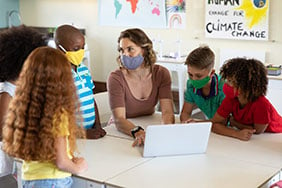Acceleration, Not Retention? The Case for Leveraging New Blended Learning Skills to Keep Students Moving Forward
 During a recent car ride to New York, I sat in the passenger’s seat while the driver kicked the speed up several notches out of my comfort zone, to better accommodate our time schedule. After initially bracing myself for the speed, I realized how exhilarating it was to travel so quickly. We didn't drive fast the entire trip, just long enough to get back on schedule safely. Afterwards, we returned to a normal pace enjoying the scenery and breeze.
During a recent car ride to New York, I sat in the passenger’s seat while the driver kicked the speed up several notches out of my comfort zone, to better accommodate our time schedule. After initially bracing myself for the speed, I realized how exhilarating it was to travel so quickly. We didn't drive fast the entire trip, just long enough to get back on schedule safely. Afterwards, we returned to a normal pace enjoying the scenery and breeze.
There are many factors that contribute to learners falling behind the proverbial schedule, some of which have little to do with ability. Global crises such as the health upheaval experienced in 2020 only increased skill gaps that have long existed. Systemic inequities, under-resourced and underfunded schools, as well as interrupted education also contributed to students falling behind. Our job as educators is to help students get where they need to be on time. Just how do we accomplish this? We put our foot on the gas, kick it up a notch, and accelerate.
There is a misguided understanding in education when it comes to traditional remediation and promotion criteria that students must master all previous concepts prior to learning new content. This often results in countless hours of skill and drill teaching as learning gaps widen, and students lose both their motivation and excitement to learn. Additionally, remediation practices do not build strong learning practices, student’s self-perception or a sense of agency, all of which are necessary to academic success. A better approach is to employ acceleration practices, including rigorous instruction and opportunities for productive struggle. While remediation seeks to rescue students from challenges, acceleration strategies train students to persist in the face of challenge. Productive struggle provides students with rigorous activities and assignments, as well as time to reflect on what and how they learn, which are necessary for a healthy sense of agency. Blended learning practices are the perfect tools for providing the type of learning environment where students feel supported and challenged at the same time, and are a great strategy for operationalizing acceleration in the classroom.
 There are many forms of blended learning to consider using to support learner acceleration:
There are many forms of blended learning to consider using to support learner acceleration:
The flipped classroom is uniquely fitted to support learner acceleration:
- Learners can access content prior to face-to-face instruction.
- Content instruction can be paused and rewinded as many times as the learner needs.
- Flipping instruction frees the teacher up to support students with hands-on, higher level Bloom’s tasks such as analyzing or creating during face-to-face instruction.
Stations are a great strategy to support learner acceleration. A teacher led station can be leveraged for:
- Re-teaching to promote student learning and motivation.
- Providing just in time supports where knowledge gaps can be filled prior to introducing new content.
- Teacher check-ins and conferencing.
- Providing feedback and next steps.
The collaborative station in a station rotation can be leveraged to support learner acceleration by:
- Reinforcing new learnings in a group setting where peers can support each other.
- Introducing collaborative problem solving to improve upon skills.
- Reviewing vocabulary and key concepts together.
In addition to these blended learning strategies teachers should also consider:
- Identifying and addressing any unfinished learning needs so students can be successful with new content.
- Making connections between content and students’ lived experiences. When content is relevant to students, their engagement increases. Students need to be engaged to learn and relevance is a huge factor in engagement.
- Providing “just in time” scaffolds. This requires that teachers anticipate the skills students will need to understand to learn new content. This can be as simple as creating bookmarks with graphics or bullets of prior content.
- Immersing students in new content using a mulit-modal approach. If students are learning new vocabulary and concepts, create opportunities for them to read, watch short videos, or podcasts.
I’d love to hear your thoughts on ways you’ve begun to shift your practice or strategies you’ve brought into your classroom to accelerate learning. You can email me at rohiatousiby@linclearning.com or find me on Twitter @Siby_Rohiatou. Be sure to check back here for some great upcoming blogs and resources from more of our LINC coaches.
Additional Resources
Learning in the Fast Lane by Suzy Pepper Rollins
7 Instructional Strategies for Accelerating Student Learning by Meg Bowen
Planning for Acceleration in the 2020-2021 School Year TNTP, Reimagine Teaching